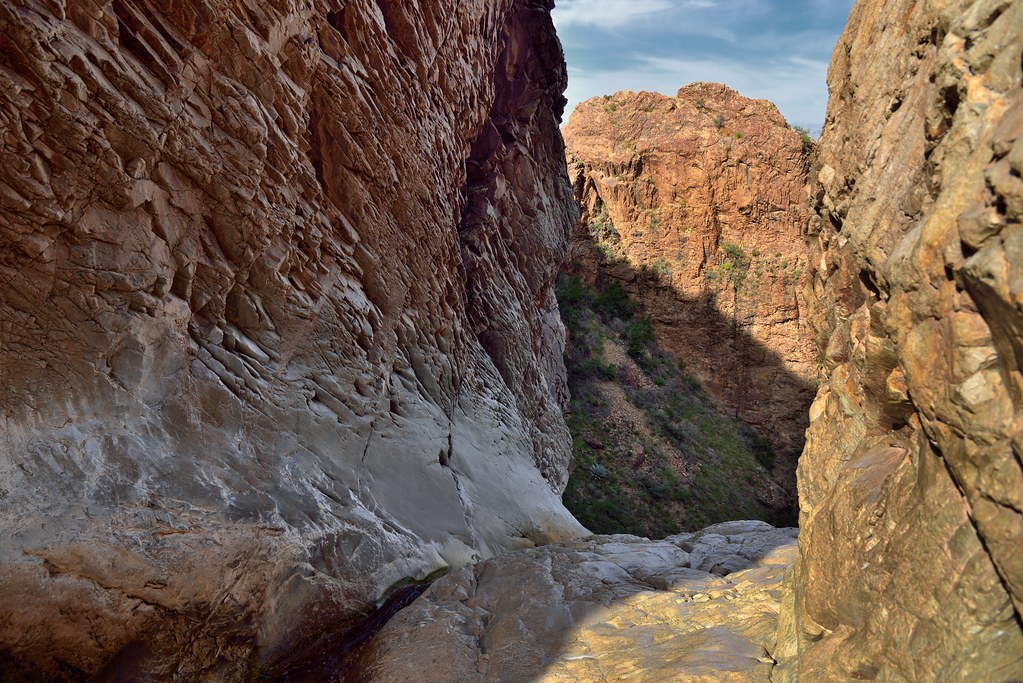#Trans-Pecos Texas Ranges
Video
Only the Wind Kept Me Company That Morning by Mark Stevens
Via Flickr:
At a roadside pullout along Texas State Highway 54 with a view looking across the Chihuahuan Desert to the northwest. My thought on composing this image was to use some Highground that I was located on next to this fence line and capture a sweeping view across this desert landscape with the small shrubs and wild grasses leading up to the Sierra Diablo Mountains off in the distance. I decided to keep the horizon more or less centered with the image so that I could include some of the clouds in the skies above. I liked how that was a color contrast to the earth-tones in the lower portion of the image. The rest of the composition was exposing the image to get a correct lighting, given the morning sunshine that was coming from behind and still low in the skies above.
#Azimuth 287#Day 2#Looking NW#Nikon D850#White Sands and West Texas New Mexico#Intermountain West#Southwest Basins and Ranges#Trans-Pecos Texas Ranges#Van Horn Area#Sierra Diablo Mountains#Blue Skies with Clouds#Blue Skies#Chihuahuan Desert#Desert#Desert Landscape#Desert Plant Life#DxO PhotoLab 5 Edited#Landscape#Landscape - Scenery#Mountain Peaks#Mountains#Mountains in Distance#Mountains off in Distance#Nature#No People#Outside#Roadside Pulloff#Roadside Stop#Rolling Hillsides#SH 54
1 note
·
View note
Text

#mountain ranges#grassland#silouette#yellow sky#big bend national park#texas trans pecos#chihuahuan desert
5 notes
·
View notes
Text

"Bighorn Sheep used to roam in Texas, but by 1960, they were gone [due to hunting and disease]. Now, Bighorn are found in mountain ranges from the Rio Grande to the northern Trans-Pecos, and the herd is more than 1,500 strong."
The reintroduction is ongoing, with pen-raised animals, along with populations from Nevada, being brought in over the years.
0 notes
Text
Environmental degradation in the US’s deserts: the Mojave
Just thinking about Joshua trees, as one does, since they were recently in the news since local National Parks staff couldn’t adequately monitor recreation use in the Mojave.
The 3 true deserts of North America are pretty ecologically sensitive. These deserts are used as playgrounds by recreationists (the Mojave); by the US military (the Sonoran); and by ranching industries (the Chihuahuan). In the midst of discussion of the federal US government shutdown’s effects on the Mojave Desert and Joshua trees, it’s worth noting just how unique and sensitive both the tree and the nearby desert ecology are. Regardless of the recent US federal employee furlough’s effects on land management, Joshua trees are already bound for local extinctions, due to soil degradation, climate change, urban growth, and US military shenanigans.
Here are some examples of the Joshua tree (Yucca brevifolia) featuring in national headlines lately, in the context of the shutdown:



-
Joshua trees as an emblem of the Mojave Desert:
I’m not a botanist! Ask a botanist for better info about the Joshua tree’s physiology and ecology.
But, put generally, the Joshua tree is a strange plant with an ancient lineage, and they are an iconic endemic species representative of the unique Mojave Desert ecoregion. They can grow to about 14 meters in height; live for several hundred years; have large flowers and odd fruit; and give the desert landscape an alien-planet-looking vibe.
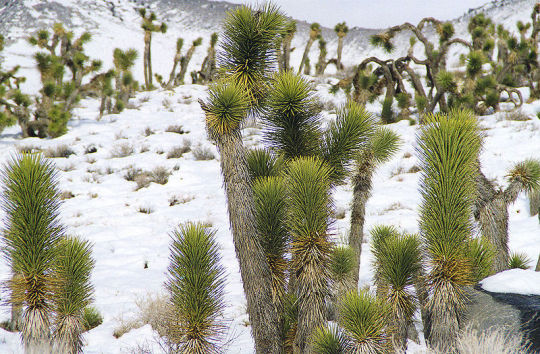
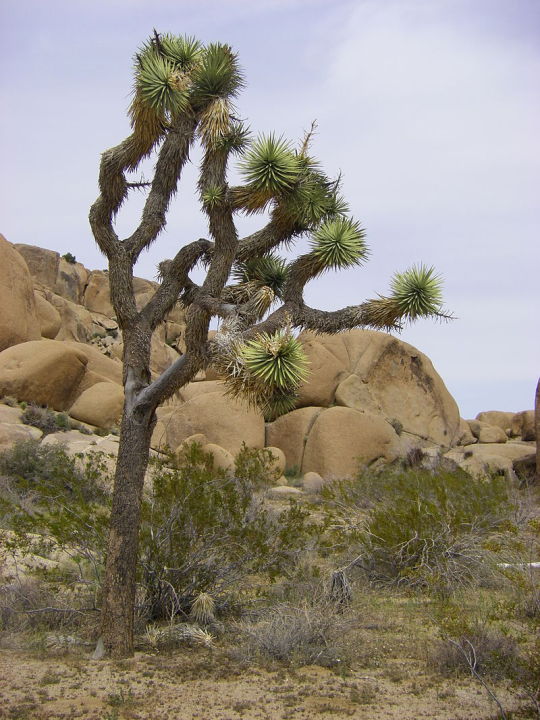

(Source 1; 2; 3)
-
If you’ve been to Joshua Tree National Park, you’ll know that educational literature and interpretive signs love to play-up the fact that the administrative boundaries of the park straddle the border between 2 dramatically different deserts: the Mojave Desert and the Sonoran Desert.
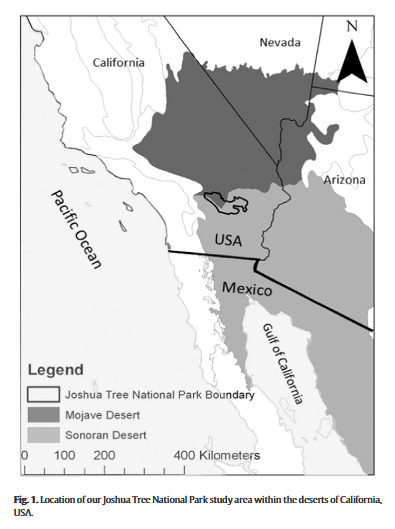
(Source.)
The national park, then, harbors the ecology of 2 of the 3 true deserts of North America. (The other, 3rd North American true desert is the Chihuahuan Desert of Chihuahua, New Mexico, and Texas’s Trans-Pecos region)
The Joshua tree itself, however, is basically endemic to only the Mojave Desert (which is to say that it lives almost entirely within the Mojave, with only the occasional sporadic existence outside of the Mojave in isolated spots in the northern Sonoran Desert).
The species is an emblem of the Mojave Desert. Compare the Joshua tree’s current distribution (on right) with the ecological boundaries of the Mojave Desert (on left).
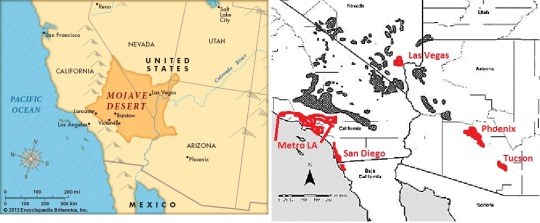
(Mojave Desert map from here.)
-
Urban population growth and Joshua trees:
The titular national park essentially functions as the backyard of the US’s “second city”: Los Angeles. The park is easily accessible as a day-trip from any part of LA.
San Diego and Las Vegas can easily access the park as well.
Here’s a closer look at the distribution range of Joshua trees:

Cross-hatched areas are current distribution of Joshua tree. Triangles are fossilized preserves of prehistoric (early Holocene) distribution. Red areas are heavily urbanized areas with a combined population of 31 million people. (Map originally from this study of Joshua tree phylogeography; labels added by me.)
I think it’s not discussed often enough that the “wilderness” of some major national parks in the contiguous US is sometimes so overrun that they become de facto domesticated recreation centers for nearby major urban areas.
- Everglades National Park sits directly alongside 6 million people in Greater Miami
- Mt. Rainier National Park is situated halfway between 4 million in the Seattle-Tacoma urban area and another 3 million in the Portland urban area
- Great Smokey Mountains sits right against 1 million or so people in Knoxville, Asheville, and Chattanooga while also seeing tourists from nearby Atlanta and Charlotte
In the case of Joshua Tree National Park:
LA (#2), Phoenix (#13), and San Diego (#18) are all in the top 20 most populous US urban areas. Phoenix is among the top 10 the fastest-growing major US urban areas, and Las Vegas isn’t far behind in rate of population growth.
The Mojave is becoming even more of a recreational playground. The range of the Joshua tree is immediately surrounded by these urban areas with a combined population of 31 million people or more.
The US military also wastes an egregious amount of space in the Mojave and Sonoran Deserts, under the lazy pretext that the deserts are empty and not intrinsically valuable, despite the extraordinary biodiversity of the Sonoran Desert between Mexicali and Nogales especially (including iconic, geographically-isolated species like rosy boas; gila monster; saguaro; Joshua tree; native desert palm species; etc.). Much of the Arizona-Mexico border is cordoned-off and wasted on military training space, despite its incredible ecological distinction.
-
Climate/ecological crisis effects of Joshua tree:
Lead author Dr. Ken Cole, of the Colorado Plateau Research Station in Flagstaff, in a 2005 report, provided some maps that predict the near-future range contraction that will be suffered by Joshua trees.
Here’s what the distribution range of the Joshua tree looks like now ...
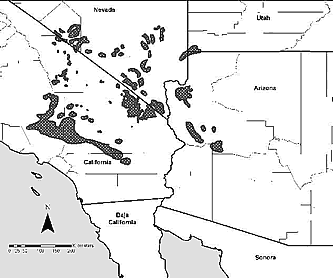
... compared to what the distribution range of the Joshua tree should like in 25 years, in the very best-case scenario.
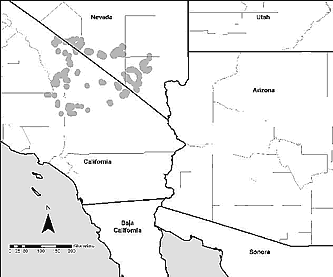
This projection of future Joshua tree distribution has been criticized for being inaccurate due to being “markedly optimistic” because this successful continued existence was projected based on the assumption that Joshua trees can be 10-times more successful at seed dispersal than they really are in the wild.
This projection was also made before the great climate science of the past 15 years fully revealed just how much worse the ecological collapse will probably be compared to earlier projections.
Again, I’m not a botanist! But the apparent trend here is: This range contraction will mean that Joshua trees - already limited to the Mojave Desert alone - will disappear from a majority of the Mojave.
-
Adding to the ecological uniqueness of the area, Joshua Tree National Park doesn’t just sit at the intersection of the Mojave Desert and Sonoran Desert ecoregions, but it also rests against another ecological boundary with the Mediterranean chaparral and Baja peninsular island mountain range ecology of the southern California coastline. This mild and unique coastal Californian ecology has its own set of many endemic species with small and isolated distribution ranges. This landscape, of course, is also in jeopardy, since the majority of this ecology - only really existing between roughly San Francisco Bay and Tijuana - has already been consumed by California’s human development.
-
Anyway. Deserts are not featureless wastelands. Joshua trees are just one of many other comparably unique, exemplary, or charismatic plants and animals with narrow, endemic distribution ranges in the North American deserts.
14 notes
·
View notes
Text
Graduate position:
--_000_BY1PR0601MB10641EDF969E6804980CAE0889870BY1PR0601MB1064_ Content-Type: text/plain; charset="us-ascii" Content-Transfer-Encoding: quoted-printable A graduate position in mammalogy with focus on evolution and conservation is available in Caleb Phillips' laboratory (http://bit.ly/2wzo2tH). The position will be supported by a Texas Parks and Wildlife State Wildlife Grant. Funding is secured to provide the student with experience as a Research Assistant as well as a Teaching Assistant, and part of tuition and fees costs will also be covered. The abstract from the funded grant proposal is provided below. During the course of research the position will include a) field work in the Trans-Pecos Ecoregion of Texas, b) travel to museums in the United States for voucher specimen sampling and morphological measurements, c) DNA sequencing and phylogenetic analysis, d) niche modeling, e) presentation and f) publication of culminated work. Thus, a highly motivated person wishing to gain expertise in these areas will be successful. Given the scope of work, a PHD student is preferred, but a highly motived person wishing to pursue a MS will also be considered. The Phillips Laboratory approaches a variety of questions by integrating ecological and evolutionary theory with bioinformatic and cell and molecular biology. That said, the applicant will receive a diverse exposure to wet lab research, programming and statistics through their own work and through interaction with other lab members. Interested persons should email [email protected] to provide a CV and cover letter with a statement of interest. Be sure and put "fulviventer" in the subject line so it isn't overlooked. Preferred start date is the January 2018 (Spring 2018 semester). Abstract: The tawny-bellied cotton rat, Sigmodon fulviventer dalquesti, is a poorly understood Texas endemic that is listed as a Species of Greatest Conservation Need. S. f. dalquesti is only known from a single opportunistic sampling 26 years ago; 20 individuals were collected approximately 18 miles southwest of Fort Davis (Chihuahuan Desert Ecoregion; Stangl 1992a). The population was found to be viable, as the 20 individuals included juveniles as well as reproductively active males and females. Formal subspecific status of S. f. dalquesti was based on morphological comparisons to a New Mexican subspecies, S. f. minimus, in which S. f. dalquesti was found to be craniometrically larger and have distinct pelage characteristics (Stangl 1992b). Based on proximity of distribution, it was hypothesized that S. f. dalquesti is most closely related to S. f. minimus, yet the single known locality of S. f. dalquesti is about 200 km separated from the eastern edge of the S. f. mini mus distribution. Subsequent phylogenetic work on the genus Sigmodon included comparison of S. f. dalquesti to a central Mexico subspecies, S. f. fulviventer, using the full mitochondrial Cytochrome b gene (Peppers et al. 2002). These subspecies were found to be a little more than 1% genetically divergent (i.e. 12 base pair differences across 1140 base pairs). Based on an accepted mammalian molecular clock, this level of genetic difference roughly equates to 100,000 years of divergence and at least 200,000 generations. Thus, limited existing data indicate that S. f. dalquesti is a genetically and morphologically distinct Texas endemic. However, Bradley and Schmidly (2016) remarked that the range and population size of this subspecies remains unknown, and the above cited publication is the only known detection of S. f. dalquesti. This perspective, as well as its state abundance rank of S1, indicate the need to develop an improved understanding of S. f. dalquesti biology. Proposed field work will help to clarify S. f. dalquesti occurrence and distribution, and will help inform best conservation plans for this population. In addition to field efforts to more accurately define S. f. dalquesti distribution, morphological and phylogenetic analyses will be used to establish evolutionary relationships among subspecies. This important missing information will confirm S. f. dalquesti morphological and genetic affinities, and will explain distinctness of S. f. dalquesti in comparison to all geographically proximate lineages. A clear understanding of S. f. dalquesti evolutionary distinctness is essential to conservation action. For example, the presumed rarity of S. f. dalquesti, along with its apparent genetic and morphological uniqueness, contrast sharply with the current Global Rank of G5 (i.e. secure- common; widespread and abundant). Work proposed herein will provide the data necessary to form an accurate conservation assessment. --_000_BY1PR0601MB10641EDF969E6804980CAE0889870BY1PR0601MB1064_ Content-Type: text/html; charset="us-ascii" Content-Transfer-Encoding: quoted-printable
<
via Gmail
0 notes
Text
Environmentalists urge French bank not to finance Texas fracking LNG project
New Post has been published on https://workreveal.biz/environmentalists-urge-french-bank-not-to-finance-texas-fracking-lng-project/
Environmentalists urge French bank not to finance Texas fracking LNG project
Environmental companies have referred to as on a French financial institution no longer to help finance a fracked-gasoline export terminal planned for south Texas.
A file released on Wednesday urges BNP Paribas and its US subsidiary, a bank of the West, to state it’s going to no longer finance any initiatives for liquefied natural fuel (LNG) terminals and to adopt a coverage of no longer backing Texas LNG export schemes. One of the proposals would be constructed on 1,000 acres of land, doubtlessly making it the biggest facility of its type in the country.
“It’s a harmful fossil gasoline infrastructure assignment inside the Gulf coast in One of the extraordinarily untouched components,” stated Jason Opeña Disterhoft of the Rainforest Motion Community, of the plan known as Texas LNG.
texas oil field
He stated there “is a few hypocrisy” in BNP’s involvement for the reason that the organisation touts its green credentials. Within the wake of the 2015 Paris settlement to cope with weather change, the bank said it was devoted to responsible investment, along with financing renewable electricity in place of coal mining and minimising atmospheric pollutants due to its business activities.
France banned fracking in 2011 for environmental protection reasons. A spokeswoman for BNP’s US operation declined to comment on the file. Texas LNG did now not respond to a request for remark.
Rebekah Hinojosa, an activist preventing the terminals, fears that creation could harm sacred Local American historical websites, harm endangered flora and fauna, tourism and the local shrimping industry and polluted and scar a quite whole part of the coast, in addition, to threaten protection in the event of a catastrophe. Although proponents tout capacity financial benefits for a disadvantaged area, Hinojosa is involved that the projects may result in the long run fee greater jobs than they invent.
“This field is the seashore of Texas. People come from all over the kingdom and another close by states to our beach due to the fact we’re the ultimate unindustrialised piece of coast alongside the Texas coastline,” she said. “It doesn’t have a refinery or smokestacks on the horizon.”
Three LNG terminals are proposed for a part of the Rio Grande valley close to the metropolis and port of Brownsville and the spring wreck vacation spot of South Padre Island, one in every of Texas’s most famous beach in regions. They would be only more than one miles from the metropolis of Port Isabel, which has a population of about five,000.
The agencies are hoping to take benefit of the fracking boom in Texas’s Eagle Ford shale formation, with gasoline to reach the Gulf coast thru a new pipeline before being liquefied and exported to global markets.
However, the file warns that the bank “is contributing to various severe capability weather, environmental and social effects” by acting as an economic adviser for the challenged loan for the Texas LNG terminal.
Despite the oil and gasoline downturn, companies are expanding into the few last elements of Texas which are surprisingly untouched using the power enterprise. Protesters set up camps in far flung west Texas around the flip of the year to combat the almost-finished Trans-Pecos Pipeline, to delivery herbal fuel to Mexico and are being built by using strength Switch Companions, the firm behind the controversial Dakota Get admission to the pipeline.
To the north, a popular oil and fuel subject called Alpine High has been located, and environmentalists worry it could threaten a country park.
More than a hundred and ten LNG centers are running inside the US and 12 export terminals proposed in Texas, Louisiana, Florida and Mississippi, consistent with America authorities’ Federal strength Regulatory Commission, with another 19 import or export terminals authorised for production in North The us.
texas lng project
Germany has begun to harden its stance with the United Kingdom over Brexit, with its finance minister caution that Britain could face Ecu price range payments for greater than a decade even after severing political ties with the bloc.
Wolfgang Schäuble’s feedback will dash Theresa can also hope that Berlin would assist to meet demands – specifically France’s desire to ensure the UK will pay a substantial charge for voting to leave the European.
François Hollande, the French president, is worried that giving Britain a smooth ride could encourage anti-European forces in France to call for a vote on the club of the bloc.
“Until the United Kingdom’s go out is entire, Britain will truly have to fulfil its commitments,” Schäuble informed the economic Instances (paywall). “Probable there can be some commitments that last past the go out … even, in the element, to 2030. Also, we can’t provide any beneficial rebates.”
He Also warned that the UK need to observe extensive regulations on investment incentives inside the wake of the put up-Brexit commitments given by using Downing Street to Nissan. The Asian carmaker eventually introduced that it will construct two new models at its large Sunderland plant in the coming years.
“These policies apply to all, whether or not European members or no longer,” Schäuble told the newspaper.
At a dinner in Paris attended using Jean-Claude Juncker, Ecu Fee president, and the European’s top Brexit negotiator, Michel Barnier, in October, Hollande said: “There ought to be a hazard, there ought to be a danger, there should be a rate. Otherwise, we will be in a negotiation that cannot give up well.”
G20 rules on tax avoidance could restrict Britain’s ability to provide tax breaks to companies, even after it left the European, the German minister argued. He stated: “the UK continues to be a member of the ECU and it’s far a country which has usually upheld the legitimate regulations, valid laws and legal treaties.”
In a blow to Britain’s commercial services area and the status of the metropolis, Schäuble subsidised needs for London to lose its euro-clearing business. He Additionally said the UK should put together to lose commercial offerings firms to towns inclusive of Frankfurt within the wake of Brexit.
Neither ought to the UK anticipate different preparations on migration if it wanted to remain within the unmarried marketplace. “There may be no à Los Angeles carte menu,” he instructed the Toes. “There may be only the complete list or none.”
He introduced: “Without membership of the inner market, Without popularity of the four simple freedoms of the internal marketplace, there can, of course, be no passport, no loose Get right of entry to for monetary products or for financial actors.”
Even earlier than the 23 June referendum, the finance minister had adopted a hardline stance if British citizens opted to leave the bloc.
In an interview with Der Spiegel, the influential veteran flesh-presser ruled out the possibility of the United Kingdom following a Swiss or Norwegian version that might allow it to enjoy the benefits of the single market Without being a European member.
“That ain’t work,” Schäuble stated. “It’d require the use to abide via the regulations of a club from which it presently wants to withdraw.
“If most people in Britain opts for Brexit, that could be a choice towards the single market. In is in. Out is out.”
Scott Morrison has subsidised the concept of the use of authorities bonds to elevate less high, long-term finance for lower priced housing to be deployed through a less costly housing finance organisation.
In an interview with Radio National on Friday, the treasurer Also signalled that the government might cut or redirect funds from the $1.3bn-a-yr Countrywide less expensive housing settlement, pronouncing he was “very pissed off” with its performance.
Underneath the bond aggregator model, the Commonwealth would enhance up to $200m through government bonds, which may be used to provide loans to community housing vendors or the personal region to offer social or inexpensive housing.
On Friday Morrison announced a brand new low-priced housing task force to expand the bond aggregator version, to be led via the former chief govt of the brand new South Wales Treasury business enterprise Stephen Knight, and which include the Treasury secretary, John Fraser, and the chief executive of the network Housing Industry Affiliation, Peta Winzar. The task force will file by way of mid 12 months.
On Radio Countrywide Morrison stated the version laboured remote places to assist make new tendencies commercially possible – along with within the United Kingdom, wherein he studied the scheme on the go to in January.
Morrison stated the proposal would help “the developing wide variety of Humans on low incomes who are going through mental strain”.
The treasurer said and less expensive housing finance employer could be “now not the entire answer. However, it has virtually been part of the solution in many elements of the arena”, suggesting it’ll shape one plank of the government’s housing package deal within the may also budget.
finance
Requested if the idea could gain only renters, Morrison said “there are models to allow [people] to subsequently buy the houses inside the circumstances”, suggesting a rent-to-purchase scheme became Additionally Beneath attention.
The chief executive of the NSW Federation of Housing Associations, Wendy Hayhurst, welcomed the announcement, saying that attracting large scale institutional investment would be “critical to establishing the community housing sector as a third tier of the Australian housing market”.
0 notes
Photo
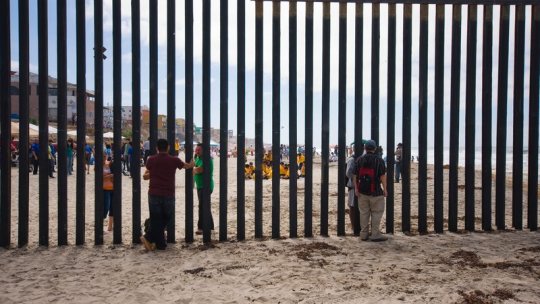


What Geology Has to Say About Building a 1,000-Mile Border Wall
Last month, President Donald Trump took steps to make good on a campaign promise to turn the United States’ existing border fence into a "big, beautiful" wall. On January 25, the White House issued an Executive Order announcing the creation of a “secure, contiguous, and impassable physical barrier … to prevent illegal immigration, drug and human trafficking, and acts of terrorism.” Now the U.S. Customs and Border Protection—the office tasked with enforcing border regulations—is scrambling to make that order a concrete reality.
Today’s fence consists of roughly 650 miles of disparate segments, made out of a combination of steel posts and rails, metal sheeting, chain link, concrete vehicle barriers and wire mesh. To replace that fence with what has been described as a 20- to 50-foot concrete structure that will traverse 1,000 of the some 2,000 miles of the U.S.’s border with Mexico will be no easy feat. Besides dealing with a proposed Mexican lawsuit and navigating the private ownership of much of Texas’ lands, there is another concern few have addressed in detail: geology.
Compared to building a marble palace or high-steepled church, erecting a wall may seem relatively straightforward. It isn’t. (Just ask the Chinese, whose Great Wall took 2,000 years to build and failed to keep out invaders.) Though most wall designs are fairly simple, builders must adapt to a wide range of terrains, explains Gary Clendenin, a senior hydrogeologist at ICF. The southern U.S. border alone contains desert, wetlands, grasslands, rivers, mountains and forests—all of which create vastly different problems for builders.
“The length of this thing presents challenges that just aren’t typically undertaken in a construction project,” says Clendenin.
Can these hurdles be overcome? Smithsonian.com asked two scientists, a geophysicist and a hydrogeologist, which geologic factors the wall’s builders should take into account first if they are to execute this ambitious project.
Surveying the Situation
The Tower of Pisa was never meant to lean. Built between 1173 and 1370, the off-kilter structure was positioned atop roughly 30 feet of fine river sediments underlain by a layer of ancient marine clay. But as builders assembled the tons of marble, the river sediments didn’t compact evenly. So by 1178, when they had finished work on the third story, the tower had already acquired its characteristic tilt.
The Italian government has since spent millions of dollars to make sure this beloved landmark doesn't topple over. Such structural failures serve as a reminder that, while our ancestors did manage to successfully erect many impressive feats, “they don’t necessarily stay upright,” in the words of field geophysicist Mika McKinnon. To circumvent such problems today, modern builders have added a crucial step to the construction process: surveying. Though time-consuming, this step is critical to ensure that the resulting structure can remain standing on terra firma for years to come.
Before a single brick is laid, teams of scientists assemble on scene to investigate a litany of details, from bedrock depth to soil chemistry. In the case of the border wall, they would have to traverse the entire length of the proposed path, working in segments to evaluate the region, collect data, develop plans. (This necessity makes the process of erecting walls—especially ones spanning thousands of miles—more challenging than building, say, a 95-story skyscraper.)
“Quite frankly, that would take years to do,” says Clendenin, who specializes in linear projects like railways and roads. McKinnon agrees. One project she worked on, a three-mile stretch of pipeline, is now on year five of field surveys.
Yet Trump’s order appears to allow a mere six months for all surveying and planning efforts. Within its long list of required steps, his executive order states:
“Produce a comprehensive study of the security of the southern border, to be completed within 180 days of this order, that shall include the current state of southern border security, all geophysical and topographical aspects of the southern border, the availability of Federal and State resources necessary to achieve complete operational control of the southern border, and a strategy to obtain and maintain complete operational control of the southern border.”
When contacted by Smithsonian.com, the Customs and Border Protection agency declined to comment on the current timeline for the wall, saying in an email that "it would be speculative to address the questions that you're asking at this point.” But according to scientists Smithsonian.com spoke to, it isn’t going up anytime soon.
…
Getting to Bedrock
The prehistoric city of Petra stands as a prime example of ancient geologic foresight. Around the 4th century BC, Petra’s inhabitants carved the basis for this once-bustling trading city directly into the rugged pink and tan sandstone cliffs between the Red Sea and the Dead sea. Though winds and rain threatened to erode the structure top down, its firm rooting in bedrock—the solid rock that lies beneath the earth’s loose layers—has kept this structure standing tall for thousands of years.
Such grounding in bedrock is a key feature when building a megastructure, says McKinnon. For something as extensive as a 1,000-mile wall that stands upwards of 20 feet tall, builders will need to anchor the whole thing beneath the surface to the underlying rock if they want it to stay upright.
The problem is, getting to bedrock can be a doozy. Great swaths of the border feature a hefty layer of loose sediments—dirt, soils, sand—laying atop the bedrock. In some regions the bedrock is hundreds if not thousands of feet down. “Some places the bedrock will be too deep—you'll never be able to reach the bedrock in an affordable fashion,” says McKinnon.
“That's okay if you want to [build] a tiny house because you just have it floating on its foundation,” she adds.
But if you’re building a megastructure, “you have a problem,” she says.
That’s not to say that building on sand is impossible. But to safely erect such structures, geophysicists today conduct extensive seismic surveys to image what lies beneath. To create these pictures, they install rows of spike-like geophones, which are 3D microphones that detect minute vibrations of the ground, converting them into an electric signal. Then they make a large noise, often by triggering an explosion or using a heavy weight to thump the ground. The geophones record the scattering and reflection of vibrations to image underground structures, and tease out problems that may lay under the surface.
McKinnon experienced one of these problems firsthand, during the construction of a hydroelectric dam that was meant to be built across a valley that spanned about a mile. The team did all the proper surveys of the region, and discovered that beneath their riverbed lay a second channel buried in dirt. “If we hadn't found it and we tried to build our dam across, then the water would have just eroded that old channel underneath and we would have had a river under our dam,” she says.
There are two options for overcoming such problems with sediment: compact the sediment and add a deeper foundation. For a wall roughly 20 feet tall, the foundation should extend six to eight feet beneath the surface, Clendenin says. All of these steps are expensive and time-consuming. But skimp on any of them, and "you get your Leaning-Tower-of-Pisa situation," says McKinnon.
Of course, many modern regions don’t have the economic resources to do such surveys and construction of deep foundations. The cities of Campania, Italy, are built atop loose sediments that are prone to sliding—a situation worsened by local clearcutting of the vegetation and unregulated construction that commonly lacks adequate foundations. These factors leave them vulnerable to the whims of their region’s geology: In 1998, when a mudslide rippled through the city, the houses crumpled under the weight and movement of the sludge, leaving at least 95 dead.
...
Dirt Drama
“Something there is that doesn't love a wall / That sends the frozen-ground-swell under it,” begins Robert Frost’s poem "Mending Wall." Frost may not have been a geological surveyor, but he got one thing right: When it comes to building walls, soil swelling is a major headache. That’s why, after surveyors finish assessing the kind of rock and earth they’ll be building over, they start studying the dirt.
Sediments, particularly in clay-rich materials, can take on water, swelling like a sponge in a bowl of water. The resulting cycles of swelling and shrinking during wet and dry periods can crack the very foundation of structures. And these types of soils are common in many states where the border wall will be built, including Texas and parts of New Mexico. In fact, about half of American homes are built on soils that expand significantly, and nearly half of those suffer damage yearly because of the soil, according to the American Society of Civil Engineers.
Dirt can also eat up the wall’s support system. Soils that are naturally acidic or have high chloride levels can rapidly degrade iron-rich metals, says McKinnon. These soils could “corrode any, say, nice big metal rebar that you're putting in there to stabilize your foundation,” she says. Other soils have a high amount of sulfates, a compound found in the common mineral gypsum that breaks down both metals and concrete. Sulfate-rich soils are common in what’s known as the Trans-Pecos soils along the border in the southwestern arm of Texas.
“You're going to encounter hundreds, if not thousands, of different types of soils along [such a lengthy] linear pathway,” says Clendenin. (In fact, there are over 1,300 kinds of soil in Texas alone.) And many of those soils aren’t going to be the right type to build on top of. At that point, would-be wall-builders have two options: Spend more time and money excavating the existing soils and replacing them with better dirt—or avoid the region altogether.
One thing they can’t always avoid, though, are regions at risk of earthquakes and floods. Rivers run along a sizeable portion of the U.S.-Mexico border, which can create a very real danger of flood. Building adjacent to rivers can also present unexpected legal issues: A 1970 treaty necessitates that the fence be set back from the Rio Grande river, which delineates the Texas-Mexico border. Because of this, the current fence crosscuts Texas landowner’s property and has gaps to allow landowners to pass.
Earthquakes are also relatively common in the western U.S. Depending on the build, some of these tremblors could cause cracks or breaks in the wall, says McKinnon. One example is the magnitude 7.2 quake that struck in 2010 near the California-Mexico Border, according to Austin Elliott, a postdoctoral student at the University of Oxford whose research is focused on the history of earthquakes. “If there had been a wall at El Centinela [a mountain in northern Mexico] it would have been offset,” Elliott writes on Twitter.
…
Even if all the proper surveys are completed and the boxes checked, success isn’t guaranteed. “There are just so many things that have to be done before you even shovel out the first scoop of dirt,” says Clendenin.
Despite all of our modern surveying tools and careful planning, the earth will still surprise you, adds McKinnon. “This part that you thought was boring and simple and easy to predict is actually totally complicated,” she says. “Look at any major excavation for a subway system, any major bridge construction, any large tower complex; all of them had intense surveys beforehand, extensive design phases, and still had to modify while building.”
After the announcement of Trump’s Executive Order, McKinnon took to Twitter to leave a foreboding reminder of the consequences of underestimating the Earth. “Earth doesn’t forgive sloppy,” she wrote. She added in an interview: “Ignore geology at your peril.” [h/t]
Photographs
Some 650 miles of disparate segments of fence stand along the almost 2,000-mile border between the U.S. and Mexico. Many segments, like the one pictured above, still allow some communication across the border.
The border fence that runs through the Algodones Sand Dunes in California is of special construction to accommodate the ever-changing dune environment. The narrow, 15-foot-tall posts "float" above the sand and can be moved vertically as the dunes shift. (United States Border Patrol, Department of Homeland Security)
Upkeep of such a lengthy structure is challenging. And even if such a wall can be erected, the size of budget necessary to keep it standing remains unclear.
#american history#architecture#economics#geography#geology#immigrants#politics#us government#donald trump#mexico#smithsonian
0 notes
Video
Only the Wind Kept Me Company That Morning by Mark Stevens
Via Flickr:
At a roadside pullout along Texas State Highway 54 with a view looking across the Chihuahuan Desert to the northwest. My thought on composing this image was to use some Highground that I was located on next to this fence line and capture a sweeping view across this desert landscape with the small shrubs and wild grasses leading up to the Sierra Diablo Mountains off in the distance. I decided to keep the horizon more or less centered with the image so that I could include some of the clouds in the skies above. I liked how that was a color contrast to the earth-tones in the lower portion of the image. The rest of the composition was exposing the image to get a correct lighting, given the morning sunshine that was coming from behind and still low in the skies above.
#Azimuth 287#Day 2#Looking NW#Nikon D850#White Sands and West Texas New Mexico#Intermountain West#Southwest Basins and Ranges#Trans-Pecos Texas Ranges#Van Horn Area#Sierra Diablo Mountains#Blue Skies with Clouds#Blue Skies#Chihuahuan Desert#Desert#Desert Landscape#Desert Plant Life#DxO PhotoLab 5 Edited#Landscape#Landscape - Scenery#Mountain Peaks#Mountains#Mountains in Distance#Mountains off in Distance#Nature#No People#Outside#Roadside Pulloff#Roadside Stop#Rolling Hillsides#SH 54
1 note
·
View note
Text
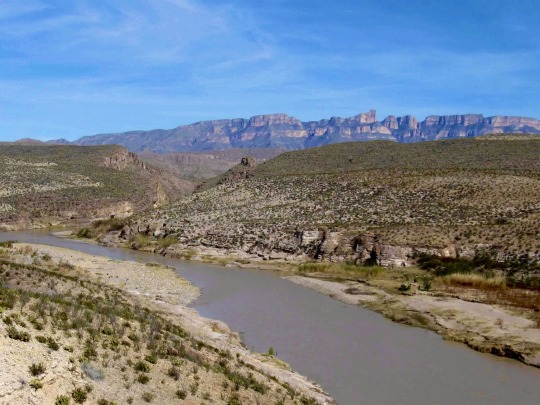
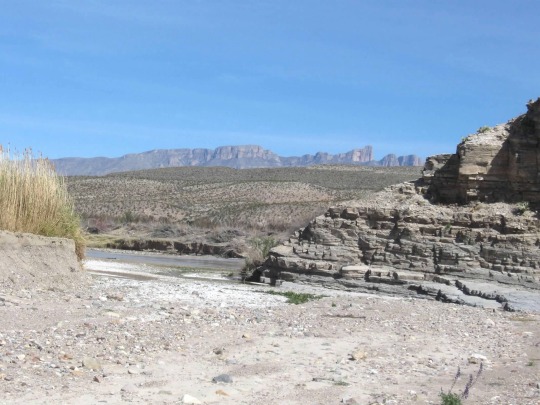

#rio grande river#sierra del carmen#mexico (mt. range in distance)#Big Bend NP#texas trans pecos#chihuahuan desert#photos by me
6 notes
·
View notes
Text
[Unitierracalifas] UT Califas Fierce Care ateneo, 01.28.17, 2.00-5.00 p.m
Compañerxs
The Universidad de la Tierra Califas' Fierce Care Ateneo will gather on Saturday, January 28, from 2.00 - 5.00 p.m. at Miss Ollie's / Swans Market (901 Washington Street, Oakland, a few blocks from the 12th Street BART station) to continue our regular, open reflection and action space to explore questions and struggles related to the emerging politics of fierce care as well as some of the questions below.
J20 arrived with full streets. As promised, we witnessed mobilizations from all quarters with a wide array of constituencies and types of action engaged. The energy began percolating once the election results were clear and it was evident that the nation would have to endure at least four years of Donald Trump's presidency. The convergences, protests, student walk-outs, strikes, (such as the one voted on J19 by the dock workers in the seven ports of California) and direct actions in streets, on railway tracks, and a range of public spaces across America including those that targeted corporate sites colluding with or at the center of a right wing back lash were noteworthy and necessary.
The day after the week of marches and mobilizations, especially and including the Women’s March, begs a critical question that everyone has already been asking: after the marches what next? And what exactly happened over the week with the culmination of the mobilization on Saturday? The Women's March on Washington and the mobilizations across the country far outweighed the inauguration and the juxtaposition confirmed what we already know: that while the Trump administration and it's bombastic claim to "make America great again" does not represent large numbers of the American population, there is a repression descending that will impact us all. The bumbling mendacity of the transition team not withstanding, the Trump presidency represents the extreme of American arrogance, an attitude that reflects the most shrill notes of American (neo)liberalism.
Some argue that despite the spectacular success of the Women's march, we should be cautious about what it represents especially noting how it possibly signals the privatization of struggle given the dominance of the non-profit sector in all facets of the effort. We have also noticed that many news channels celebrated the march as the beginning of a “social movement,” a strategic claim in the professionalized joust over words and numbers between Trump and the press. The march was notable for the participation of ordinary women and their supporters, but mainstream participation from a disproportionately white crowd can also portend a certain level of de-politicization even though it is actually a profound moment of civic engagement. The question is what to do with this contradiction in a moment when we must (re)build grassroots institutions. By grassroots institutions we do not mean NGOs or 501(c)3s, rather we mean those moments when folks claim the arts of self-governance in locally rooted efforts by relying on what they already know —citizens actively making decisions not about their security or defense, but about their regeneration and the safety/space required for it. "Although the majority is not accustomed to self-government," explains Gustavo Esteva, "the impulse is profound and general. No one needs to be trained to do it. It begins at home when we create the conditions for the whole family, even young children and the elderly, to participate in the decisions that affect everyone. It then moves to the condominium, the street, the neighborhood, to all the spheres of reality in which every person moves." (see, Esteva, "Aprender a gobernarnos" <http://www.jornada.unam.mx/2017/01/16/opinion/016a1pol>)
The inauguration speech left little doubt that the Trump administration will invest heavily in a repressive apparatus to manage the mobilized outrage that will only grow as Trump and his cronies loot what they can as they can. It should be of no surprise who Trump and the white supremacists he empowers around him will blame for the violence across the country. As he stated in his inaugural: "And the crime, and the gangs, and the drugs that have stolen too many lives and robbed our country of so much unrealized potential. This American carnage stops right here and stops right now." No matter how clumsy it might be, it still signals a commitment to blame the victims. Kali Akuno of the Malcom X Grassroots Movement warns, "all of us, the veterans and rookies of struggle must get prepared for the worse —massive surveillance, repression, imprisonment, isolation, and assassination. We would be fools to take the new situation lightly. We must learn, really learn, from the failures of societies and movements in the past that failed to fully challenge white nationalism and fascism as they emerge, and even more so when they get a grasp of power. We have entered a period where sacrifice, self-sacrifice of the highest order, is imperative. If we don't view the situation this way, and resist as if our lives depended upon it (which they in fact do), we will find ourselves either back in the 16th century or extinct. So, people should expect intense repression and get prepared to make tremendous sacrifices." (see, "How to Prepare for the 'Trumpocalypse': Notes from an Organizer"<http://www.telesurtv.net/…/How-to-Prepare-for-the-Trumpocal…>) From across the nation, groups working on the ground brace for an anticipated spike in violence: deportations and the breaking up of families and communities, the ramping up of militarized policing, incarceration and surveillance, and political repression in myriad forms. Groups targeted during the campaign and their allies have organized sanctuary spaces and have begun implementing defense strategies. Beyond national borders, we brace for the legitimatization of more violence, including those violences exacted through increased settlements in Palestine and escalating tensions with Iran.
Reclaiming America through enhanced security measures, it seems abundantly clear to most that Trump's presidency will usher in a new era of militarized violence. But, the violence has been with us. Many have been contesting it for generations. And there seemed to be no respite with the Obama presidency. Many mainstream Americans, for example, have not been completely aware of the price paid by communities defending mother earth, especially the cost borne by communities confronting extractive industries directly. For those disenfranchised by the neoliberal machine and engaged in these struggles for survival, the violence is everywhere —in the privatization and poisoning of water, the destruction of forests, the infiltration of crops by genetically modified agents, the poisoning of the air including from the very paint on the walls in homes of primarily Black and Brown communities. (see, "Fruitvale District Has Highest Levels of Lead Poisoning in California" <https://www.indybay.org/newsitems/2017/01/12/18795313.php>)
In the turmoil of the election and leading up to the inauguration, mobilizations have been growing across the country against pipelines. While the Whitehouse.gov website quickly scrubbed all references to many social justice issues including climate change, angry citizens and Indigenous communities have joined forces in the Trans-pecos region and extended the efforts in Standing Rock to stop yet another pipeline, declaring a moratorium on environmentally destructive drilling and pipelines. (see, Derek Royden, "Fighting the Black Snake at Two Rivers: How Standing Rock-style protest came to west Texas" <http://www.nationofchange.org/…/fighting-black-snake-two-r…/>) The sacrifices of Indigenous communities at the front lines of the battle to protect the earth are gaining strength and visibility in the U.S., and continue to be central to Indigenous resistances and struggles for survival across Mexico and the rest of Latin America. But the costs have been great. On January 15, Isidro Baldenegro López, a Tarahumara who dedicated his life to protecting the forests in his native Chihuahua was shot to death by a lone gunman. Baldenegro's assassination recalls the death of Berta Caceres (March 2016) who was also struck down and taken from us for her tireless devotion to the environment and her community. (see, Nina Lakhani, "Second winner of environmental prize killed months after Berta Cáceres death."
<https://www.theguardian.com/…/isidro-baldenegro-lopez-kille…>) Both "community leaders" had earned world-wide recognition for their work. Yet the awards and accolades from people and institutions eager to find climate solutions could not prevent their murder. Even as the climate accords are being dismantled at pace with other protective measures including national health care, we are forced to interrogate the role of large institutions in protecting those on the frontlines of climate change. How can we reclaim our communities against such senseless and cynical violence by those few who only know to plunder, to take for themselves. Global Witness' "On Dangerous Ground" reports that "more than three people were killed a week in 2015 defending their land, forests, and rivers against destructive industries." In the investigation, Global Witness "documented 185 killings across 16 countries —by far the highest annual death toll on record and more than double the number of journalists killed in the same period." Brazil alone witnessed 50 killings of people fighting forms of extratavist capital in 2015. (see, "On Dangerous Ground" <https://www.globalwitness.org/en/reports/dangerous-ground/>)
There is little disagreement that Trump's acceptance speech was a blatant, bombastic populist appeal ringing the same bell he has rung since he entered the race: to make America great again. But what does that mean exactly? It can only mean that America will continue to enjoy its lifestyle, now even less and less available to the "middle class," at the expense of the rest of the world. And, this lifestyle will be maintained through violence —a violent apparatus that has long been in place. Witness America's intolerance of the pink tide —as popular movements rose up to overturn neoliberal regimes, most notably in Uruguay to Venezuela, but even washing up on the shores of Greece.
In opposition to the war and to advocate peace throughout the world W.E.B Du Bois warned that America, the nation forged through a bond between capital and labor, depended on the exploitation of the "darker peoples of the world." Du Bois explained that the thin veneer of democracy was not for working people to have a say in government as part of democratic nation. Rather, the perception of belonging to the nation worked to prevent people from recognizing that their lifestyle came at another worker's expense; they enjoy only a slightly better life as a result of the degradation of another worker in the Global South. It is this democratic despotism that makes "the nation" intolerant to independence and self-determination outside its borders even though it claims to be both the arbiter and defender of democracy. (see, W.E.B Du Bois, "African Roots of War."<https://www.globalwitness.org/en/reports/dangerous-ground/>) It is the U.S.'s insistence on "democracy" across the globe, and the commitment to impose it everywhere, that costs so many lives.
But the election of Trump signals a break in the consensus of what the nation means. Even the show trials, such as the extradition of El Chapo, are not even believable to mainstream Americans anymore. According to Akuno, "In the immediate future, we can definitely expect that the ongoing resistance will have a broad, diverse, and autonomous character. This in itself is not a bad thing. But, I would note that it is not necessarily a good thing either, as without a higher degree of political and strategic alignment and coordination between the various social movements and political forces mounting the resistance, we won't be able to withstand the onslaught that the Trump regime and the reactionary neo-Confederate forces are planning to unleash. So, we have to overcome the fragmentation that has plagued the left in the United States for decades, and be clear that we cannot rely upon the liberals and the Democrats to be consistent and principled allies in the struggle against the resurgence of white nationalism."
North Bay Crew
NB: If you are not already signed-up and would like to stay connected with the emerging Universidad de la Tierra Califas community please feel free to subscribe to the Universidad de la Tierra Califas listserve at the following url <https://lists.resist.ca/c…/mailman/listinfo/unitierracalifas>. Also, if you would like to review previous ateneoannouncements and summaries please check out UT Califas web page. Additional information on the ateneo in general can be found at: <http://ccra.mitotedigital.org /ateneo>. Find us on tumblr at <http://uni-tierra-califas.tumblr.com>. Please note we have altered the schedule of the Democracy Ateneo so that it falls on the second Saturdayof the month from 2.00 to 5.00 p.m. and the Fierce Care Ateneo convenes on the fourth Saturday of the month from 2.00 to 5.00 p.m.
0 notes
Video
A Hillside of Trees Before a Mountainside of Textures and Colors (Big Bend National Park) by Mark Stevens
Via Flickr:
While the greens and yellows of nearby hillside trees was definitely a strong contrast to the mountainside, what I also wanted to capture with this image was the mountainside with its details and colors. The skies above would complement the complete setting for this image.
#Nikon D800E#Day 4#Trip to Big Bend National Park#Big Bend National Park#Window Trail#Ward Mountain#Looking SSW#Chisos Mountains#Capture NX2 Edited#Color Efex Pro#Intermountain West#Southwest Basins and Ranges#Trans-Pecos Texas Ranges#Big Bend Ranges#Hike to The Window#The Window Trail#Desert#Desert Landscape#Desert Plant Life#Desert Mountain Landscape#Outside#Nature#Landscape#Mountains#Mountains in Distance#Mountains off in Distance#Mountainside#Sunny#Blue Skies with Clouds#Trees
2 notes
·
View notes
Video
A Shadow Cast Across the Side of Casa Grande (Big Bend National Park) by Mark Stevens
Via Flickr:
This was a view I took in as I neared the Chisos Mountains Lodge after a hike back from The Window. With some proper metering and placing my SLR camera into manual mode, I was able to bring down the appearance of the exposure even with the bright light coming from the afternoon sun. As with an image I captured earlier that morning, I decided to compose the image by including a portion of the mountainside leading up to the peak. I felt that having peak near the top of the image seem to compliment the grand view of…Casa Grande.
#Nikon D800E#Day 4#Trip to Big Bend National Park#Big Bend National Park#Window Trail#Chisos Mountains#Casa Grande#Looking SE#Capture NX2 Edited#Color Efex Pro#Intermountain West#Southwest Basins and Ranges#Trans-Pecos Texas Ranges#Big Bend Ranges#Casa Grande Peak#Hike to The Window#The Window Trail#Desert#Desert Landscape#Desert Plant Life#Desert Mountain Landscape#Outside#Nature#Landscape#Mountains#Mountains in Distance#Mountains off in Distance#Mountainside#Sunny#Blue Skies with Clouds
1 note
·
View note
Video
A Hiking Trail in Big Bend National Park by Mark Stevens
Via Flickr:
This was a view looking to the northeast while hiking back to the Chisos Mountains Lodge from The Window. Quite simply, what I wanted to capture with this image was the hiking trail I was on. I felt that the hiking trail was kind of a leading line heading off into the distance. With the cactus plants and the other desert-mountain vegetation all around, it kind of led the eye forward to the rugged mountainside of Pulliam Peak off in the distance.
#Nikon D800E#Day 4#Trip to Big Bend National Park#Big Bend National Park#Window Trail#Chisos Mountains#Looking NE#Pulliam Peak#Capture NX2 Edited#Color Efex Pro#Intermountain West#Southwest Basins and Ranges#Trans-Pecos Texas Ranges#Big Bend Ranges#Hike to The Window#The Window Trail#Desert#Desert Landscape#Desert Plant Life#Desert Mountain Landscape#Outside#Nature#Landscape#Mountains#Mountains in Distance#Mountains off in Distance#Mountainside#Sunny#Blue Skies with Clouds#Trees
1 note
·
View note
Video
Nearby Walls of a Mountainside with Skies and Clouds Above (Big Bend National Park) by Mark Stevens
#Nikon D800E#Day 4#Trip to Big Bend National Park#Big Bend National Park#Window Trail#Canyon View#Mountainside#Looking SE#Chisos Mountains#Capture NX2 Edited#Color Efex Pro#Intermountain West#Southwest Basins and Ranges#Trans-Pecos Texas Ranges#Big Bend Ranges#Hike to The Window#The Window Trail#Desert#Desert Landscape#Desert Plant Life#Desert Mountain Landscape#Outside#Nature#Landscape#Mountains#Mountains in Distance#Mountains off in Distance#Sunny#Blue Skies with Clouds#Trees
1 note
·
View note
Video
Greens and Yellows Leading up a Mountainside (Big Bend National Park) by Mark Stevens
Via Flickr:
A view looking to the east up Pulliam Peak while on a hike back from The Window while in Big Bend National Park. While I admit this was an amazing view looking up this mountainside, what I also liked and what drew me into this image was the setting of greens and yellows going up this mountainside. I felt that it was just the right color contrast to the blues and whites of the skies above.
#Nikon D800E#Day 4#Trip to Big Bend National Park#Big Bend National Park#Window Trail#Pulliam Peak#Looking East#Chisos Mountains#Capture NX2 Edited#Color Efex Pro#Intermountain West#Southwest Basins and Ranges#Trans-Pecos Texas Ranges#Big Bend Ranges#Hike to The Window#The Window Trail#Desert#Desert Landscape#Desert Plant Life#Desert Mountain Landscape#Outside#Nature#Landscape#Mountains#Mountains in Distance#Mountains off in Distance#Mountainside#Sunny#Blue Skies with Clouds#Trees
1 note
·
View note
Video
Walls of The Window and Peaks Beyond (Big Bend National Park) by Mark Stevens
Via Flickr:
Just to the point to not venture further with the slick rocks but still far enough to capture that view beyond...
#Nikon D800E#Day 4#Trip to Big Bend National Park#Big Bend National Park#Window Trail#The Window#Carter Peak#Vernon Bailey Peak#Looking NW#Chisos Mountains#Capture NX2 Edited#Color Efex Pro#Intermountain West#Southwest Basins and Ranges#Trans-Pecos Texas Ranges#Big Bend Ranges#Hike to The Window#The Window Trail#Outside#Nature#Landscape#Mountains#Mountains in Distance#Mountains off in Distance#Mountainside#Sunny#Blue Skies with Clouds#Chihuahuan Desert#US Biosphere Reserve#Using The Window as a Frame
1 note
·
View note





